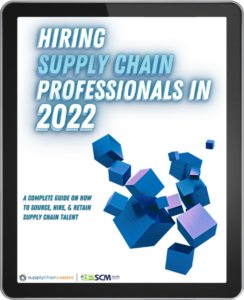
How to Retain Supply Chain Talent – New Challenges & Solutions
Retaining supply chain talent in an atmosphere of tight supply can be a constant struggle. It may feel like a whack-a-mole game. Just as you fill one vital role, another is needed, possibly due to growth, new products, or the loss of a key employee to another company. Given that the market is fluid and people change jobs continuously, how do you do keep the people that are vital to the company’s success? Talent retention is one of the most essential facets of running a successful business. Although retaining talent in supply chain management is necessary to preserve a company’s knowledge, high morale, satisfied customers, and even sales growth, retention strategies and practices may be overlooked or unclear. The ability to maintain employees over time makes a huge impact on both sales and profits.
What makes employees want to stay with you? What are supply chain professionals looking for in a job or career? If you find yourself unsure about what you could be doing to keep employees satisfied and avoid turnover, you are not alone.
In this article, we look at the cost of losing employees, reasons to retain talent, and some programs you as a manager or Human Resource Specialist can put in place to improve your retention of good employees.
Turnover is Increasing
As the Millennial generation has begun to dominate the workforce, turnover has increased. By 2025 according to Zety, this group will make up 75% of the workforce. A Gallup poll found that millennials have changed jobs 3 times as much in a year than their Baby Boomer counterparts. However, since the COVID-19 pandemic, there is an indication that this generation may now be intending to stay in their jobs for up to five years as opposed to two years as previously reported. The question is, how can you keep great talent from leaving every few years?
The Cost of Losing Employees
As you may be painfully aware, when productive employees leave your company, your business suffers. A Center for Accountability and Performance (CAP) study estimated that it costs up to nine months of an employee’s salary to replace an employee. It is even higher for a senior executive where an entire team is affected. This doesn’t include the impact of productivity as the new replacement trains and achieves optimum productivity. It is difficult to quantify the soft costs of hiring and training a new employee, but the impact on the bottom line can be significant.
Besides the measurable financial costs, there can also be a negative effect on the culture of those team members who remain. Employees can spend time wondering why someone left and come up with suppositions that may make them consider leaving as well. Those left can feel overworked as they are asked to pitch in and keep the productivity going while the backfilled employee is hired and fully ramped up. This ripple effect can lead to an increased number of disengaged employees, which can also cost many dollars in lost productivity.
Line Managers and Human Resource personnel who are in charge of hiring employees in supply chain management must understand what is important to each level of employee in order to put programs in place that are meaningful.
What Employees Place Value On
There are some differences in what employees want and what they place value on, depending on their positions, roles, and generation. Generally, what millennials place value on isn’t totally different from those of earlier generations—a good job, a regular paycheck, a life well-lived. However, it seems that the major distinctions are relative to the generation. According to Gallup, in their article “How Millennials Want to Work and Live,” Millennials want significantly different things out of their jobs than the Baby Boomers wanted. This is important for those in management and human resources to understand in order to be able to address these needs and, as a result, retain talent.
This list shows how the past culture compares with the future in terms of what employees currently value:
The Change in Leadership
| Past | Future |
| My Paycheck | My Purpose |
| My Satisfaction | My Development |
| My Boss | My Coach |
| My Annual Review | My Ongoing Conversations |
| My Weaknesses | My Strengths |
| My Job | My Life |
Old Retention Practices Aren’t Working
In our discussion of retaining great talent, we are spending a lot of time talking about the Millennials generation, but it is the driving force both now and in the future for supply chain management and must be addressed if you want to retain this talent. Leaders and managers want to understand their millennial talent but are missing the mark in their approach if sticking with what has been done in the past. People accepted a job and stuck with it largely due to receiving a paycheck and benefits. The status quo was just the way it was. Employees were satisfied with once-a-year reviews and salary increases. Or, maybe a team-building retreat and picnic were held occasionally to keep employees interested in staying with a job. Being unattached to a job was part and parcel of the working environment for many who would continue to stay.
These practices are no longer acceptable in today’s workplace. Now, your talent chooses careers over a paycheck and wants a sense of purpose at work. The job and their life are closely integrated. Therefore, employees want to stay with a company that focuses on their development. Managers need to go beyond the role of being the “boss” and function more as coaches who develop strengths instead of concentrating just on weaknesses. Supply chain management talent want ongoing conversations to stay engaged.
Current Talent Retention Practices
Basically, retaining talent in supply chain management, across the board, means creating an environment where your employees are valued—both today and in the future. These are some of the priorities for keeping great employees in today’s workplace.
Developing Career Paths
For many and for a variety of reasons, this generation is delaying marriage and home buying, so their priority is their career. In this mission, they are always investigating and pursuing positions at other companies, which helps companies in the recruitment of talent, but not in retention.
When recruiting, the message and branding for your company are very important. Conveying how your company values its employees and has structures in place for development should be part of your recruitment process. However, in retaining the talent, the walk has to match the talk.
Providing opportunities to learn and grow are critical in retaining talent. Creating an environment that offers challenges and situations for development is imperative. Workers are focused on improving their knowledge, skills, and career. Great talent wants to be rewarded with meaningful opportunities to advance. Retention practices must be put in place to address this need. Mentoring, coaching, and job shadowing are just a few that can be implemented.
Establishing Patterns for Workplace Engagement
Employees want to feel connected to their work and they want to contribute. Their end goal is finding a good job that gives them a sense of purpose. By putting practices in place that stimulate engagement and give them compelling reasons to stay, your retention will increase. Having regular conversations with management is a solid way to engage employees.
Good talent wants to have ongoing communication with managers and others in order to feel valued. Setting up ways to give frequent feedback and provide opportunities for interactions increases employees’ engagement. A core practice to put in place is scheduling regular one-on-one and small group meetings not only to check in on their projects but also to develop better relationships in learning what is important to them. Only then can you create more opportunities that keep engagement high.
Providing Competitive Salaries and Benefits
Pay matters to all employees, however, salary isn’t the end-all-be-all for great talent to stay with you. Yes, talent wants to know that the skills and knowledge they are bringing is valued, and compensation can be a core indicator. But, even more important are the benefits and perks. We aren’t just talking about healthcare coverage and sick leave; other benefits like stock options and financial rewards for employees who exceed performance goals or have longevity are important to talent retention.
Additionally, flexible work schedules, the ability to work remotely, and receiving generous paid leave policies help employees feel they are valued. David Hanrahan, a senior HR leader has done a lot of work in analyzing and innovating talent practices, postulates that not offering generous leave impacts the employee’s full engagement at work and creates an environment where they are distracted and resentful. This often leads to an employee looking at options with other companies.
Offering a Good Work-Life Balance
In today’s workforce, the job role is just as important as the company and the value it places on its employees. Employees want to work for companies that invest in them both as employees and as people. Supply chain management talent rate highly what a company can provide them in leading a better overall life. Almost 60% of millennials surveyed by Gallup said that work-life balance and personal well-being in a job is very important. As part of retention practices, companies need to implement programs to help employees reach their physical, community, social, and purpose goals. Putting practices in place for flexible work arrangements that may include flexible scheduling and work-from-home options can be great retention methods.
Best Practices in Retaining Supply Chain Talent
In the effort to establish programs to retain talent, use these best practices:
- Understand why employees leave through exit interviews. Track by position, department, and manager.
- Understand why employees stay. What compels them to remain employed with the company.
- Create a high feedback environment where employees feel valued.
- Invest in the development of talent to show your interest in helping them up their game.
- Provide the tools they need to perform and grow.
- Provide team engagement options that provide for tighter-knit talent groups to grow together.
- Offer policies that add to life-work balance.
- Offer competitive pay and personalized benefits.
- Provide clarity on ESG policies and ways for talent to participate.
